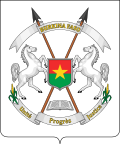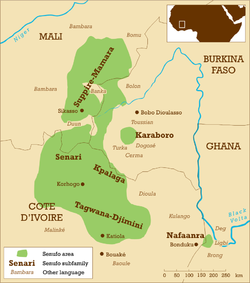Portal:Africa



Africa is the world's second-largest and second-most populous continent after Asia. At about 30.3 million km2 (11.7 million square miles) including adjacent islands, it covers 20% of Earth's land area and 6% of its total surface area. With nearly 1.4 billion people as of 2021, it accounts for about 18% of the world's human population. Africa's population is the youngest among all the continents; the median age in 2012 was 19.7, when the worldwide median age was 30.4. Based on 2024 projections, Africa's population will exceed 3.8 billion people by 2100. Africa is the least wealthy inhabited continent per capita and second-least wealthy by total wealth, ahead of Oceania. Scholars have attributed this to different factors including geography, climate, corruption, colonialism, the Cold War, and neocolonialism. Despite this low concentration of wealth, recent economic expansion and a large and young population make Africa an important economic market in the broader global context, and Africa has a large quantity of natural resources.
Africa is highly biodiverse; it is the continent with the largest number of megafauna species, as it was least affected by the extinction of the Pleistocene megafauna. However, Africa is also heavily affected by a wide range of environmental issues, including desertification, deforestation, water scarcity, and pollution. These entrenched environmental concerns are expected to worsen as climate change impacts Africa. The UN Intergovernmental Panel on Climate Change has identified Africa as the continent most vulnerable to climate change.
The history of Africa is long, complex, and varied, and has often been under-appreciated by the global historical community. In African societies the oral word is revered, and they have generally recorded their history via oral tradition, which has led anthropologists to term them "oral civilisations", contrasted with "literate civilisations" which pride the written word. African culture is rich and diverse both within and between the continent's regions, encompassing art, cuisine, music and dance, religion, and dress.
Africa, particularly Eastern Africa, is widely accepted to be the place of origin of humans and the Hominidae clade, also known as the great apes. The earliest hominids and their ancestors have been dated to around 7 million years ago, and Homo sapiens (modern human) are believed to have originated in Africa 350,000 to 260,000 years ago. In the 4th and 3rd millennia BCE Ancient Egypt, Kerma, Punt, and the Tichitt Tradition emerged in North, East and West Africa, while from 3000 BCE to 500 CE the Bantu expansion swept from modern-day Cameroon through Central, East, and Southern Africa, displacing or absorbing groups such as the Khoisan and Pygmies. Some African empires include Wagadu, Mali, Songhai, Sokoto, Ife, Benin, Asante, the Fatimids, Almoravids, Almohads, Ayyubids, Mamluks, Kongo, Mwene Muji, Luba, Lunda, Kitara, Aksum, Ethiopia, Adal, Ajuran, Kilwa, Sakalava, Imerina, Maravi, Mutapa, Rozvi, Mthwakazi, and Zulu. Despite the predominance of states, many societies were heterarchical and stateless. Slave trades created various diasporas, especially in the Americas. From the late 19th century to early 20th century, driven by the Second Industrial Revolution, most of Africa was rapidly conquered and colonised by European nations, save for Ethiopia and Liberia. European rule had significant impacts on Africa's societies, and colonies were maintained for the purpose of economic exploitation and extraction of natural resources. Most present states emerged from a process of decolonisation following World War II, and established the Organisation of African Unity in 1963, the predecessor to the African Union. The nascent countries decided to keep their colonial borders, with traditional power structures used in governance to varying degrees. (Full article...)
Selected article –
The Adar oilfield, also known as the Adar Yale, Adar Yeil or Adaril field, is an oilfield situated in the Melut in South Sudan estimated to contain about 276 million barrels (43,900,000 m3) of oil. The Chevron Corporation discovered the Adar Yale field in 1981, shortly before the start of the Second Sudanese Civil War (1983–2005). Soon after Chevron had suspended operations in 1984, Sudanese government troops began attacking civilian settlements in the area, burning the houses and driving the people away, and in the late 1990s, Nuer militias from Nasir helped the army in clearing away the people to make way for the roads and infrastructure of the oilfield.
President Omar al-Bashir inaugurated the site in March 1997, and it initially produced just 5,000 barrels (790 m3) a day. Production from this oilfield, which lies close to the borders with Sudan and Ethiopia, has the potential to bring significant economic benefits to the region. However, until recently the focus has been on clearing the population away from the oilfield rather than on a longer term strategy for developing the region. China has provided a large investment in the Adar oilfield and others in South Sudan and Sudan and has made plans to make extensive further investments. (Full article...)
Featured pictures –
Did you know (auto-generated) -

- ... that many African countries provide for legal abortion in their reproductive health laws, but such laws have been passed without grounds for legal abortion in Madagascar and in Senegal?
- ... that after the 1999 Tempe military base shooting, the Pan African Congress demanded a military funeral for the perpetrator?
- ... that Tennessee lawyer Bolton Smith was known for his work integrating African Americans into the Boy Scouts?
- ... that activist Gerlin Bean co-founded the Organisation of Women of African and Asian Descent in 1978, an event described as "a watershed in the history of Black women's rights activism"?
- ... that Mary Jane Patterson, whose mother was an African-American slave, gained a BA degree in 1862 having taken a "gentleman's course"?
- ... that young male African bush elephants in musth killed about 49 white rhinoceros
Categories
Selected biography –
Rainilaiarivony (30 January 1828 – 17 July 1896) was a Malagasy politician who served as the prime minister of Madagascar from 1864 to 1895, succeeding his older brother Rainivoninahitriniony, who had held the post for thirteen years. His career mirrored that of his father Rainiharo, a renowned military man who became prime minister during the reign of Queen Ranavalona I.
Despite a childhood marked by ostracism from his family, as a young man Rainilaiarivony was elevated to a position of high authority and confidence in the royal court, serving alongside his father and brother. He co-led a critical military expedition with Rainivoninahitriniony at the age of 24 and was promoted to commander-in-chief of the army following the death of the queen in 1861. In that position he oversaw continuing efforts to maintain royal authority in the outlying regions of Madagascar and acted as adviser to his brother, who had been promoted to prime minister in 1852. He also influenced the transformation of the kingdom's government from an absolute monarchy to a constitutional one, in which power was shared between the sovereign and the prime minister. Rainilaiarivony and Queen Rasoherina worked together to depose Rainivoninahitriniony for his abuses of office in 1864. Taking his brother's place as prime minister, Rainilaiarivony remained in power as Madagascar's longest-serving prime minister for the next 31 years by marrying three queens in succession: Rasoherina, Ranavalona II and Ranavalona III. (Full article...)
Selected country –
 |
 |
||

| |||
Burkina Faso, also Burkina, is a landlocked nation in West Africa. It is divided into thirteen regions, forty-five provinces, and 301 departments. It is surrounded by six countries: Mali to the north, Niger to the east, Benin to the south east, Togo and Ghana to the south, and Côte d'Ivoire to the south west. Its inhabitants are known as Burkinabé (pronounced [burkiːnaˈɓeː]).
Formerly called the Republic of Upper Volta, it was renamed on August 4, 1984 by President Thomas Sankara to mean "the land of upright people" in Moré and Dioula, the major native languages of the country. Literally, "Burkina" may be translated as "men of integrity", from the Moré language, and "Faso" means "father's house" in Dioula. Independence from France came in 1960. Governmental instability during the 1970s and 1980s was followed by multiparty elections in the early 1990s. Several hundred thousand farm workers migrate south every year to Côte d'Ivoire and Ghana in search of paid labour. (Read more...)
Selected city –

Lilongwe (UK: /lɪˈlɒŋweɪ/, US: /-wi, lɪˈlɔːŋweɪ/,) is the capital and largest city of Malawi. It has a population of 989,318 as of the 2018 Census, up from a population of 674,448 in 2008. In 2020, that figure was 1,122,000. The city is located in the central region of Malawi, in the district of the same name, near the borders with Mozambique and Zambia, and it is an important economic and transportation hub for central Malawi. It is named after the Lilongwe River. (Full article...)
In the news
- 30 April 2025 – Puntland–Somaliland dispute
- Puntland–Somaliland prisoner exchange
- Las Anod conflict (2023–present)
- Puntland released 15 prisoners of war in exchange as Somaliland set free 11 prisoners of war involving combatants captured during the conflict in the contested Sool region. This was the second prisoner exchange between individuals who were captured during the conflict of Las Anod, which erupted in early 2023. (Hiiraan Online) (Horn Observer)
- 30 April 2025 – Foreign relations of Somalia
- The Government of Somalia announces a ban on the entry and transit of Taiwanese passport holders through Somalia citing United Nations Resolution 2758 and the one-China policy. (Focus Taiwan) (Hiiraan Online)
- 28 April 2025 – Red Sea crisis
- The Houthis claim at least 68 people are killed and 47 others are injured in a U.S. airstrike on a prison holding African migrants in Saada Governorate, Yemen. (AP)
- 28 April 2025 – Boko Haram insurgency
- Sixteen people are killed after the explosion of a roadside bomb between the towns of Rann and Gamboru in Borno State, Nigeria. (Al Jazeera)
Updated: 12:05, 30 April 2025
General images -
Africa topics
More did you know –
- ...that members of the Senegalese rap group Daara J were hired by campaigners in the Senegalese election of 2000 to edit their speeches?
- ...that Senegalese hip hop group Positive Black Soul's name abbreviation, PBS, is a play on that of the Parti Démocratique Sénégalais, PDS?
- ...that Mamadou Diabaté, a Malian kora player, was nominated for a Grammy Award in 2005, but lost to his cousin Toumani Diabaté?
- ...that, in November 2007, The Sowetan published an article which erroneously claimed that South African political activist Dan Mokonyane had died?
Related portals
Major Religions in Africa
North Africa
West Africa
Central Africa
East Africa
Southern Africa
Associated Wikimedia
The following Wikimedia Foundation sister projects provide more on this subject:
-
Commons
Free media repository -
Wikibooks
Free textbooks and manuals -
Wikidata
Free knowledge base -
Wikinews
Free-content news -
Wikiquote
Collection of quotations -
Wikisource
Free-content library -
Wikispecies
Directory of species -
Wikiversity
Free learning tools -
Wikivoyage
Free travel guide -
Wiktionary
Dictionary and thesaurus



























































































